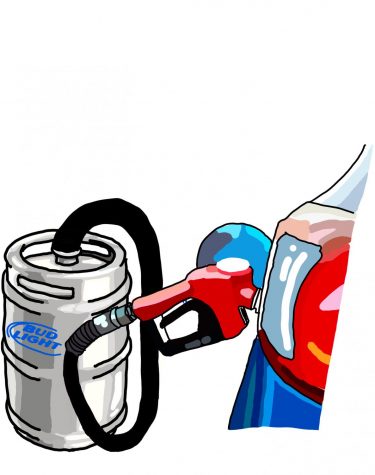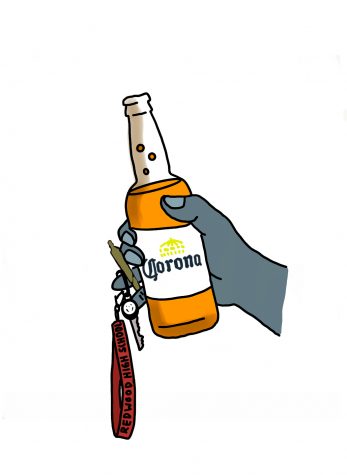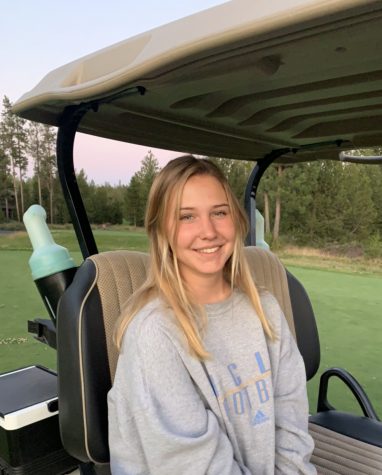
“A student at my high school, Marin Academy, in the 80s, died while drinking and driving, so the consequences are very real to me. I think most parents have experienced really horrifying consequences of people that have been drinking and driving, so [inebriated driving is] not a hypothetical. It’s a reality that we’ve experienced at some point in our life and something we’re very fearful of as parents,” Cadio Zirpoli, a parent of senior Lola Zirpoli and lifelong Marin resident said.
Although many aspects of teenage culture in Marin have changed since Cadio was in high school, driving under the influence and its deadly effects have persisted. As presented in the Bark’s December Editorial from the November Bark survey, 55 percent of Redwood students have known of a student driving under the influence, and 17 percent of students have driven with an intoxicated student behind the wheel. However, the severity of this issue isn’t confined to Marin County’s borders. Twenty-eight percent of all traffic related deaths in the nation in 2018 were caused by alcohol-induced drivers, taking the lives of 10,497 innocent drivers, as per a study by the Centers for Disease Control and Prevention (CDC). That same study also concluded that drivers under the influence of marijuana were 25 percent more likely to get into an accident than non-users.
In order to combat this epidemic, occurring both nationally and locally, some parents have already taken the initiative. Within his household of teenagers, Cadio has instilled the consequences of drunk driving in his daughters from a young age. His daughter Lola believes that these principles have contributed to the way she goes about preventing the issue as a teenager.
“Even if [my dad] didn’t say, ‘I will take your car away,’ or, ‘You won’t be able to see your friends [if you drive under the influence],’ I still wouldn’t want to do it because of the morals that I have been raised with,” Lola said.
As Lola approached an age where the prevalence of drunk driving became more significant, Cadio ensured his family had transparent conversations that prioritized his daughters’ safety, rather than focusing on the consequences of drinking without permission.
“We all have to be realistic with ourselves and acknowledge that there is the potential for [underage] drinking, and with that potential should [come] open lines of communication with your child. I’m not encouraging it and I’m not looking forward to my child drinking, but I want them to know that if it happens, there are certain choices that are right choices,” Cadio said. “I want [Lola] to be free and have the tools to make the right choices.”
According to a 2015 study by Alcohol Justice, a local alcohol and drug prevention organization, 41 percent of high school juniors in Marin reported that they had consumed alcohol in the past, with 30 percent also reporting binge drinking. In comparison, a nationwide survey sent out by the CDC in 2019 found that 29 percent of high schools reported consumption of alcohol within the past 30 days, with 14 percent also reporting binge drinking — placing Marin County 12 percent above the national average. Senior Charlie Wolfert recognizes that the frequent use of alcohol by minors in Marin contributes to the extremity of intoxicated driving in our community.
“[Driving under the influence] happens often in Marin [due to] the high drinking rate and that’s why it’s so important [to talk about] in all years of high school, because of the area we’re all growing up in,” Wolfert said.
As Wolfert noted, school curriculum can also serve as a resource to help ensure teen safety. The Tamalpais Union High School District (TUHSD) lacks an in-depth curriculum on driving under the influence and fails to explain or demonstrate the severity of the issue. For Wolfert, the brief unit on driving under the influence covered in freshman social issues classes did not suffice, considering the impact this topic has on the Redwood community.
“I honestly learned more in my Street Law class about the repercussions of drunk driving and the legal aspects [than in Social Issues],” Wolfert said.
Even with the education on the legal ramifications of driving under the influence provided by her Street Law class, Wolfert feels that the curriculum still falls short of diving into the moral reality and emotional repercussions of intoxicated driving. Wolfert feels that the TUHSD should implement courses on driving under the influence in each year of high school as this concern is not as relevant for freshmen, a majority of which do not have their driver’s licenses yet.
“A lot of people get their license sophomore and junior year, and that is also the time when people are starting to party more. In [upper-classman] English, when we’re talking about current events, that’s definitely an important topic [to cover],” Wolfert said.

The topics covered in Wolfert’s Street Law class and minimal education gained freshman year coincide with local law enforcement. However, it has not been enough motivation for students to put an end to this behavior. Jeff Peterson, a Corporal with the Central Marin Police Authority and previously a School Resource Officer, is well versed in experiences with driving under the influence and emphasizes the legal ramifications of doing so.
“The consequences are not just life and death, which is obviously the number one and the most important [consequence], but personal consequences would be [involving] law enforcement. It would be really hard to get that driver’s license back. I hope that that’s enough of a fear,” Peterson said.
Additionally, Peterson stresses that his caution of driving while impaired is not limited to the influence of alcohol. He also acknowledges that the influence of drugs, including marijuana, is often an overlooked substance when it comes to its effect on driving.
“[All substances] are very much the same. The crime of driving under the influence is really just not being able to operate a vehicle safely. A motor vehicle is potentially a deadly weapon behind the hands of somebody that’s under the influence [of any impairing substance] … Just because it’s a marijuana DUI doesn’t make it any less of a consequence in the eyes of the law,” Peterson said.
Despite the similarities of impairment between both drinking and marijuana use, the dangers of driving under the influence of marijuana are not taken as seriously as drunk driving, causing students to turn a blind eye to this risk.
Not participating in the drinking or smoking scene, junior Makena Mock has stepped up as the designated driver for her friends. Witnessing both drinking and smoking’s effect on her peers, Mock understands that driving high and driving drunk are one in the same.
“When people decide to drive high they think it’s no big deal, [and that] it is different from drunk driving because they are more relaxed. You’re still not sober and you’re still not your clearest self [when you’re high],” Mock said. “It makes me worried [because] if something happens [to them] or if a police officer pulls them over and they’re high, they can get charged [with a DUI].”
Mock’s worst nightmare has already become a reality for Redwood. A senior, who will be referred to as “Kate” for anonymity, lost a close friend to an accident involving a drunk driver. She has now become hyper aware of the potential repercussions of getting behind the wheel, especially when it comes to marijuana use.
“It’s become such a norm to be high while you’re driving. One of my closest friends does that and she drives me, and I just [think], ‘How selfish can you be to do that while I’m in the car?’” Kate said.
Given the prevalence of intoxicated driving amongst teens, curbing these dangerous practices will require dedication to the cause and cohesiveness from all members of the Redwood community. Students like Mock, who refrain from drinking or smoking and offer themselves as designated drivers, are taking the first steps to cultivate a noticeable solution.
“Even if I don’t know you that well, just come up to me [and ask], ‘Can you drive me home?’ I would say yes, because it would be really hard for me if something happened to someone who was driving under the influence,” Mock said.
As Kate understands, students must hold each other accountable before putting our lives and the lives of others at risk by driving impaired.
“People think that if you talk about it, you look emotional and dramatic. And it’s just like, ‘No, would you rather die?’ … It shouldn’t take something like [a death in the community] for us to come together.” Kate said. “Is it really worth it?”








